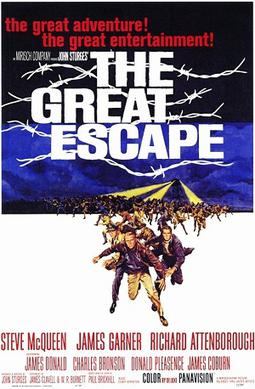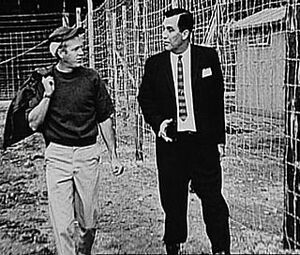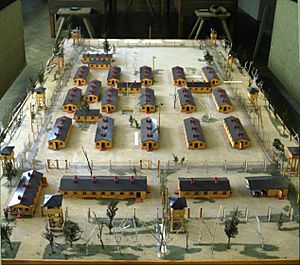The Great Escape (movie) facts for kids
Quick facts for kids The Great Escape |
|
|---|---|

Theatrical release poster by Frank McCarthy
|
|
| Directed by | John Sturges |
| Produced by | John Sturges |
| Screenplay by |
|
| Starring | |
| Music by | Elmer Bernstein |
| Cinematography | Daniel L. Fapp |
| Editing by | Ferris Webster |
| Studio | The Mirisch Company |
| Distributed by | United Artists |
| Release date(s) | June 20, 1963 (London) July 4, 1963 (United States) |
| Running time | 172 minutes |
| Country | United States |
| Language |
|
| Budget | $3.8 million |
| Money made | $11.7 million |
The Great Escape is a famous 1963 American adventure and war film. It stars well-known actors like Steve McQueen, James Garner, and Richard Attenborough. The movie's music was created by Elmer Bernstein.
The film is based on a true story from World War II. It tells a fictionalized version of a huge escape by Allied prisoners of war (POWs). These prisoners were held in a German camp called Stalag Luft III. The story comes from a 1950 book by Paul Brickhill. The movie changed some details for the big screen, including how much American prisoners were involved.
The Great Escape was made by The Mirisch Company and released by United Artists. John Sturges produced and directed it. The film first showed in London on June 20, 1963. It was very popular and got great reviews. It became one of the highest-earning films that year. Steve McQueen even won an award for Best Actor at the Moscow International Film Festival. The movie is also famous for its exciting motorcycle chase and jump scene.
Contents
Meet the Characters: The Cast
The film features many actors playing different prisoners and guards. Here are some of the main characters:
- Steve McQueen as Captain Virgil Hilts ('The Cooler King'): An American prisoner who often tries to escape. He is known for being sent to "the cooler" (solitary confinement).
- James Garner as Flight Lieutenant Bob Hendley ('The Scrounger'): An American officer who is good at finding things. He gets supplies for the escape plan.
- Richard Attenborough as Squadron Leader Roger Bartlett ('Big X'): A British officer and the main leader of the escape committee.
- James Donald as Group Captain Ramsey ('The SBO'): The highest-ranking British officer in the camp. He talks to the German guards for the prisoners.
- Charles Bronson as Flight Lieutenant Danny Welinski ('Tunnel King'): A Polish officer who is very good at digging tunnels. He has a fear of small spaces.
- Donald Pleasence as Flight Lieutenant Colin Blythe ('The Forger'): A quiet English officer who creates fake documents for the escapees.
- James Coburn as Flying Officer Sedgwick ('The Manufacturer'): An Australian officer who makes tools needed for the escape.
- Hannes Messemer as Oberst von Luger ('The Kommandant'): The German commander of the prison camp.
- David McCallum as Lieutenant-Commander Eric Ashley-Pitt ('Dispersal'): A British officer who figures out how to hide the dirt from the tunnels.
- Gordon Jackson as Flight Lieutenant Alexander MacDonald ('Intelligence'): Bartlett's helper, who gathers information.
- John Leyton as Flight Lieutenant Willie Dickes ('Tunnel King'): Danny's friend and another expert tunnel builder.
- Angus Lennie as Flying Officer Archie Ives ('The Mole'): A Scottish airman who is often worried and becomes friends with Hilts.
Making the Movie: Production
Writing the Story
In 1963, the Mirisch brothers and United Artists decided to turn Paul Brickhill's 1950 book The Great Escape into a film. Brickhill himself was a small part of the real escape team. The story had already been a live TV show in 1951, which was praised for its clever set design. The movie's script was written by James Clavell, W. R. Burnett, and Walter Newman.
Choosing the Actors

Many actors in The Great Escape had worked with director John Sturges before. This included Steve McQueen, Charles Bronson, and James Coburn, who were all in his 1960 film, The Magnificent Seven.
Steve McQueen's role as Hilts, "The Cooler King," is often seen as his best performance. Many critics say his acting in this film made him a huge star. His character was based on several real pilots.
Richard Attenborough played Roger Bartlett, "Big X," who was based on Roger Bushell. Bushell was the real mastermind behind the Great Escape. This movie helped Attenborough become well-known in the United States. During World War II, Attenborough served in the Royal Air Force. He even flew missions to film the results of bombing raids.
Donald Pleasence, who played Colin Blythe "The Forger," had also been a real prisoner of war during World War II. He was shot down and spent a year in a German POW camp. Charles Bronson, who played Danny Welinski, was a gunner in the U.S. Air Force and was wounded. Like his character, he suffered from claustrophobia (fear of small spaces) because he worked in a mine as a child. James Garner was a soldier in the Korean War and was wounded twice. He was good at "scrounging" for things, just like his character.
The German Commandant, played by Hannes Messemer, was based on Oberst Friedrich Wilhelm von Lindeiner-Wildau. Messemer himself was a POW in Russia during World War II and escaped by walking hundreds of miles.
The film shows that only three escapees made it home safely. This is true, but the people who escaped in the movie are different from the real ones. For example, the escape of Danny and Willie in the film is based on two Norwegians who escaped to Sweden.
Filming Locations
The movie was filmed in Germany, at the Bavaria Film Studio near Munich. The sets for the barracks and tunnels were built there. The prison camp itself was built in a forest clearing near the studio. Many scenes were also filmed in and around the town of Füssen in Bavaria. The famous Neuschwanstein Castle can be seen when Hendley and Blythe try to escape by plane.
The exciting motorcycle chase scenes were filmed in meadows outside Füssen. The "barbed wire" that Hilts crashes into was actually rubber strips tied around wire, made by the cast and crew. Steve McQueen was a skilled motorcycle rider and did many of his own stunts. However, the famous motorcycle jump over the fence was performed by his friend and stuntman, Bud Ekins. Ekins looked like McQueen from a distance. McQueen himself also rode the motorcycle for other parts of the chase, even playing the chasing soldiers because of his riding skills. The motorcycle used was a Triumph TR6 Trophy that was painted to look like a German bike.
How Accurate is the Film?

The film is mostly a fictional story, with changes made to make it more exciting for audiences. Many details of the real escape were changed. For example, the movie greatly increases the role of American prisoners. In reality, a few American officers helped with the early plans, but they were moved from the camp seven months before the escape. The real escape was mostly carried out by British and other Allied prisoners.
The film also doesn't mention that some Germans actually helped the prisoners with the escape.
The Music of The Great Escape
The film's famous music was created by Elmer Bernstein. He gave each main character their own musical theme based on the main Great Escape tune. This music became very popular and helped Bernstein earn money from its use for the rest of his life. Critics say the music is successful because it uses exciting military sounds mixed with softer, warmer themes. This helps audiences connect with the prisoners and feel for them. The main theme has become very popular in Britain, especially with sports fans.
A Follow-Up Story: The Sequel
A fictional TV movie sequel, The Great Escape II: The Untold Story, came out in 1988. It starred Christopher Reeve and was directed by Jud Taylor (who was an actor in the original 1963 film). This movie also tells the story of the escape, but it uses the real names of the people involved, unlike the original film.
Images for kids
See also
 In Spanish: The Great Escape para niños
In Spanish: The Great Escape para niños




